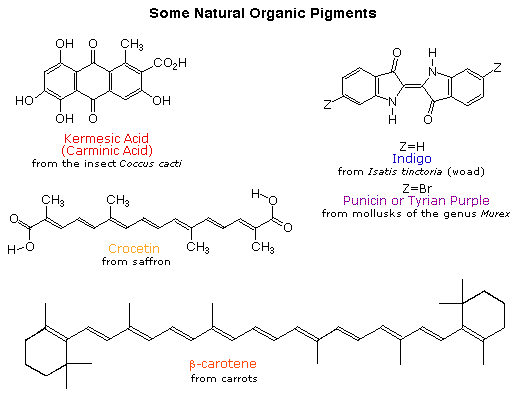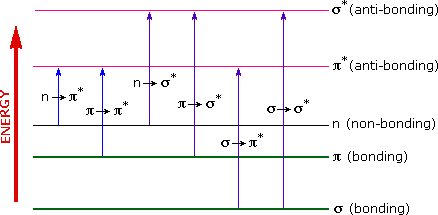
2. The Electromagnetic Spectrum
The visible spectrum constitutes but a small part of the total radiation
spectrum. Most of the radiation that surrounds us cannot be seen, but can be
detected by dedicated sensing instruments. This electromagnetic spectrum
ranges from very short wavelengths (including gamma and x-rays) to very long
wavelengths (including microwaves and broadcast radio waves). The following
chart displays many of the important regions of this spectrum, and demonstrates
the inverse relationship between wavelength and frequency
The energy associated with a given segment of the spectrum is proportional to
its frequency. The bottom equation describes this relationship, which provides
the energy carried by a photon of a given wavelength of radiation.

3. UV-Visible Absorption Spectra
To understand why some compounds are colored and others are not, and to
determine the relationship of conjugation to color, we must make accurate
measurements of light absorption at different wavelengths in and near the
visible part of the spectrum. Commercial optical spectrometers enable such
experiments to be conducted with ease, and usually survey both the near
ultraviolet and visible portions of the spectrum.
The visible region of the spectrum comprises photon energies of 36 to 72
kcal/mole, and the near ultraviolet region, out to 200 nm, extends this energy
range to 143 kcal/mole. Ultraviolet radiation having wavelengths less than 200
nm is difficult to handle, and is seldom used as a routine tool for structural
analysis.
The visible region of the spectrum comprises photon energies of 36 to 72
kcal/mole, and the near ultraviolet region, out to 200 nm, extends this energy
range to 143 kcal/mole. Ultraviolet radiation having wavelengths less than 200
nm is difficult to handle, and is seldom used as a routine tool for structural
analysis.
The energies noted above are sufficient to promote or excite a molecular
electron to a higher energy orbital. Consequently, absorption spectroscopy
carried out in this region is sometimes called "electronic spectroscopy". A
diagram showing the various kinds of electronic excitation that may occur in
organic molecules is shown on the left. Of the six transitions outlined, only
the two lowest energy ones (left-most, colored blue) are achieved by the
energies available in the 200 to 800 nm spectrum. As a rule, energetically
favored electron promotion will be from the highest occupied molecular
orbital (HOMO) to the lowest unoccupied molecular orbital (LUMO), and
the resulting species is called an excited state.
When sample molecules are exposed to light having an energy that matches a
possible electronic transition within the molecule, some of the light energy
will be absorbed as the electron is promoted to a higher energy orbital. An
optical spectrometer records the wavelengths at which absorption occurs,
together with the degree of absorption at each wavelength. The resulting
spectrum is presented as a graph of absorbance (A) versus wavelength, as in the
isoprene spectrum shown below. Since isoprene is colorless, it does not absorb
in the visible part of the spectrum and this region is not displayed on the
graph. Absorbance usually ranges from 0 (no absorption) to 2 (99%
absorption), and is precisely defined in context with spectrometer operation.
Because the absorbance of a sample will be proportional to the number of
absorbing molecules in the spectrometer light beam (e.g. their molar
concentration in the sample tube), it is necessary to correct the absorbance
value for this and other operational factors if the spectra of different
compounds are to be compared in a meaningful way. The corrected absorption value
is called "molar absorptivity", and is particularly useful when comparing the
spectra of different compounds and determining the relative strength of light
absorbing functions (chromophores).
If the isoprene spectrum on the right was obtained from a dilute hexane
solution (c = 4 * 10-5 moles per liter) in a 1 cm sample cuvette, a
simple calculation using the above formula indicates a molar absorptivity of
20,000 at the maximum absorption wavelength. Indeed the entire vertical
absorbance scale may be changed to a molar absorptivity scale once this
information about the sample is in hand. Clicking on the spectrum will display
this change in units.

|

